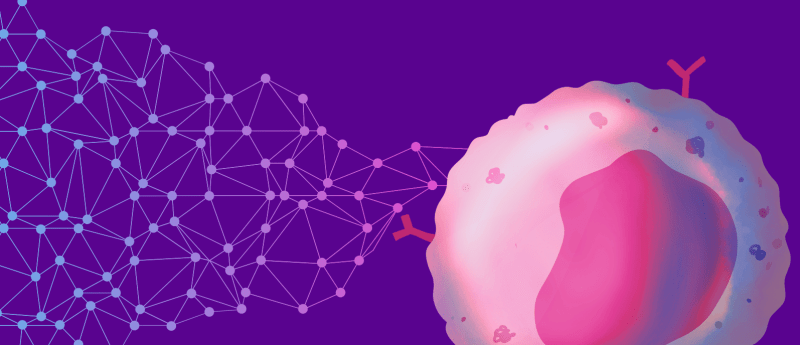AI-designed modifications to the immune system help target cancer cells

Original story from the Technical University of Denmark (Kongens Lyngby, Denmark).
A new method can produce specially designed proteins that can arm T cells to attack cancer cells.
Precision personalized cancer treatment on a larger scale has come a step closer after researchers from the Technical University of Denmark (DTU; Kongens Lyngby, Denmark) developed an AI platform that can tailor protein components and equip a patient’s immune cells to fight cancer. The new method shows for the first time that it is possible to computer-design special binder molecules that can guide the patient’s immune cells to bind to the pMHC molecules of the cancer cells.
The new AI platform dramatically shortens the process of finding effective molecules for cancer treatment from years to a few weeks.
“We are essentially creating a new set of eyes for the immune system. Current methods of individual cancer treatment are based on finding so-called T-cell receptors in the patient’s or donor’s immune system that can be used for treatment. It is a very time-consuming and challenging process. Our AI platform designs molecular structures against cancer cells, and the platform does it at an incredible speed, so we can have a new promising molecule within 4-6 weeks,” reported DTU associate professor and co-author of the study Timothy P. Jenkins.
Targeted missiles against cancer
The AI platform, developed by a team from DTU and Scripps Research (CA, USA), demonstrates targeted treatments against tumor cells and how it is possible to avoid damaging healthy tissue, which is a major challenge in cancer immunotherapy.
Usually, the body’s T cells naturally identify cancer cells by recognizing protein fragments, called peptides, that are presented on the cell surface by specific molecules called pMHCs. It is a slow and challenging process to utilize this knowledge for therapy, often because the variations in the body’s own T-cell receptors make it challenging to create a personalized treatment.
 Antivenom intelligence? The role of AI in developing snakebite treatments
Antivenom intelligence? The role of AI in developing snakebite treatments
We spoke to Tim Jenkins, an Assistant Professor at DTU, about his research incorporating artificial intelligence into antibody discovery programs to develop new snakebite antivenoms.
Strengthens the body’s immune system
In the study, the researchers tested the strength of the AI platform on a well-known cancer target, NY-ESO-1, which is found in a wide range of cancers. The team succeeded in designing a mini-binder that bound tightly to the NY-ESO-1 pMHC molecules. When the designed protein was inserted into T cells, it created a unique new cell product that the researchers called ‘IMPAC-T’ cells, which effectively guided the T cells to kill cancer cells in laboratory experiments.
“It was incredibly exciting to take these mini-binders, which were created entirely on a computer, and see them work so effectively in the laboratory,” commented DTU postdoc Kristoffer Haurum Johansen.
The researchers also used the pipeline to design binders for a cancer target in a cell sample from a patient with melanoma. It was possible to generate binders for this target as well, thus documenting that the method can be used for tailored immunotherapy against new, less well-characterized cancer targets.
 Doubling up: novel AI models improve de novo peptide sequencing
Doubling up: novel AI models improve de novo peptide sequencing
Two new AI models work together to enable more precise de novo peptide sequencing.
Screening of treatments
A crucial step in the researchers’ innovation was the development of a ‘virtual security check’. The team used AI to screen their designed mini-binders and assess them against pMHC molecules found on healthy cells. This method allowed them to screen out mini-binders that could cause dangerous side effects before conducting experiments.
“Precision in cancer treatment is crucial. By predicting and excluding cross-reactions already in the design phase, we could reduce the risk associated with designed proteins, and thus increase the likelihood of a safe and effective therapy,” concluded DTU professor and co-author of the study Sine Reker Hadrup.
Five years to treatment
Jenkins expects that it will take up to five years before the new method is ready for the first clinical trials in humans. When the method is ready, the course of treatment will be similar to current cancer treatments with genetically altered T cells, so-called CAR-T cells, which are currently used to treat lymphoma and leukemia.
In the treatments, patients will first have a blood sample taken at the hospital, just like a routine blood test. After this, their immune cells are extracted from the blood sample and processed in the laboratory so that they can wear the AI-designed mini-binders. The enhanced immune cells are returned to the patient, where they act as targeted missiles that precisely find and eliminate cancer cells in the body.
This article has been republished from the following materials. Material may have been edited for length and house style. For further information, please contact the cited source. Our press release publishing policy can be accessed here.